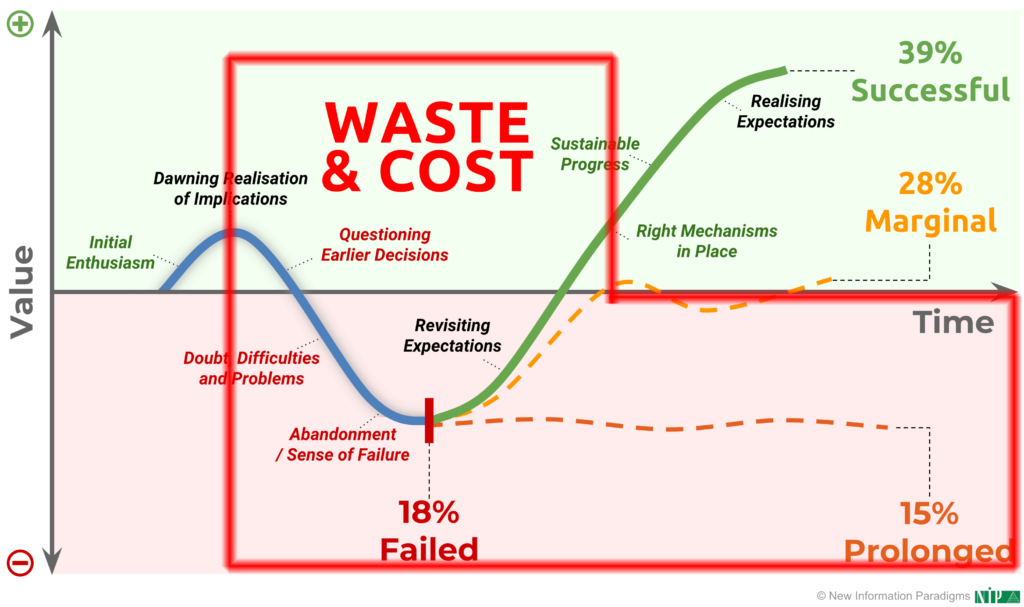Why “Things That Matter” really do matter: Part 3: They’re Not Working

- Part 1: What are “Things That Matter”?
- Part 2: What are we currently doing?
- Part 3: Why aren’t the Things That Matter working?
- Part 4: What’s the alternative?
- Part 5: Why does it work?
“Things That Matter” is the foundation of our Value Management approach.
But it seems obvious what it means, and even more obvious that the Things That Matter are what everything we do should be centered on. So, what more is there to say? What does this add that people aren’t already doing? What are the big insights here?
This series answers these questions – and many others – to show precisely how and why the Things That Matter really do matter, and so let’s continue with how and why what we’re currently doing isn’t working.
Why aren’t the Things That Matter working?
To understand the challenges we saw last time – how and why the Things That Matter aren’t working at the moment – we need to understand three related factors:
- Complexity
- Resulting trends
- Our existing approaches
Let’s look at each in turn.
The first factor: complexity
We begin by stepping back to look at the context for all this, and that context is Complexity.
At this point, you’ve probably often seen our world described as “VUCA” – Volatile, Uncertain, Complex and Ambiguous – but whilst our world is certainly all of these, the acronym is misleading.
Complexity isn’t just one factor of four; it’s the root of all the other factors.
In other words, things are volatile, uncertain and ambiguous precisely because of Complexity, and so whilst it’s not as catchy, “C-UVA” would be a more accurate acronym – not just to describe what’s going on, but also to explain it.
To then massively over-simplify complexity science, Complexity starts with lots of interconnected people and organizations, and lots of information flying around amongst them.
This leads to constant, self-reinforcing and accelerating change from all directions, and in Complexity terms, that’s called “emergence”: change that’s self-organised, bottom-up, and that creates something new that’s greater than the sum of what was there before.
All this then leads to growing unpredictability, disruption and risk… and we’ve then got a pretty accurate description of what we’re all experiencing.
Our world is fundamentally Complex.
But in recent decades, with the growth of the Internet, broadband connectivity, the incredible uptake of smart phones and other devices, the rise of social media and – most recently – the arrival of AI, technology has accelerated every aspect of complexity from the bottom up.
And it’s done so to an unprecedented level:
- There’s been an explosion in the speed, amount, availability and immediacy of information.
- There’s now extraordinary connectivity, and interdependence.
- Options for how to interact have multiplied exponentially, with barriers of cost and geography either reduced or eliminated.
We’ve arguably never experienced such fast and profound change.
The second factor: resulting trends
Many large-scale trends directly follow from, and reflect, Complexity – e.g. how unrest in one part of the world can cause disruption worldwide – but there are two of these trends that are particularly relevant.
The first is an increasing shift towards subjective Things That Matter:
- The shift of “power” from the supplier to the consumer, with greater emphasis on softer forms of “value”, in things like sustainability or values-based investing.
- We see it in how services have often overtaken products – think of the growth of Software as a Service (SaaS), and how it’s often ideas and experiences that are now most valued.
- More generally, consider how perceptions often now seem more important than facts (hence the “fake news” neologism).
Subjectivity is increasingly important.
But secondly, so are relationships: they’re a fundamental aspect of what “causes” Complexity, but they’re also central to navigating it – hence the growth of outsourcing, the push towards relational contracting models and collaborative working.
We all know that relationships are critical, but the issue is that they’re not working as they need to:

Only about 40% really meet or exceed expectations, and that’s likely a conservative estimate (e.g. according to some sources, around a third of relationships don’t even start due to failed negotiations, so they don’t even get on this curve!).
And why aren’t relationships working as they need to?
Because our existing approaches mostly aren’t fit for purpose, and that’s because they’re predominantly top-down.
The third factor: our existing approaches
This is mainly the legacy of when change was much slower in the past, when we felt able to define and control things, and focus and optimize around more objective Things That Matter.
It’s why we mostly structure our organizations vertically, and it’s reflected in the nature of most of our contracts and in the focus of traditional KPIs – everything is put into order, defined and controlled.
But than creates two traps:
- We’re too prescriptive: we treat situations in the same way when, as we discussed earlier, each situation is significantly unique – all-important Things That Matter get missed.
- We’re too exhaustive with standards, capability development programmes, and so on: we try to make sure that nothing gets missed – the specific Things That Matter in any given situation can get lost.
And of course, we’re often prescriptive and exhaustive, which is even worse…!
Next, anything top-down usually ends-up bolted-on – not collectively-owned and baked-in – and it doesn’t “stick”, which is then part of a disconnect between leadership and the front line:
- Things like corporate values are often not that specific or directly actionable, and when new best practice or training comes on top of operational overload, leaders can seem out of touch to those at the front line.
- Meanwhile, leaders do often feel out of touch, because information flows down far faster than it flows up to them.
And finally here, the things we’ve been talking about – contracts, mission statements, charters and so on – tend by their nature to either remain static or to be slow to change, so there’s a real challenge to agility, resilience and adaptability.
What we’re currently doing is therefore working against reality.
We’re trying to pin down and control things that are constantly changing and unpredictable; we’re trying to work top-down when things are increasingly happening bottom-up; and so on.
Whilst this didn’t cause too many issues in the past – when things were relatively stable and slow-moving – accelerating Complexity has really exposed the fault lines, the associated waste and cost are now obvious, and the challenges of Complexity are only going to intensify:

We need an alternative, and whilst AI will help in some areas and may buy us a bit of time, overall the gap between what we’re currently doing and what we need to be doing is only going to get wider.
We’ll look at that alternative in Part 4.

